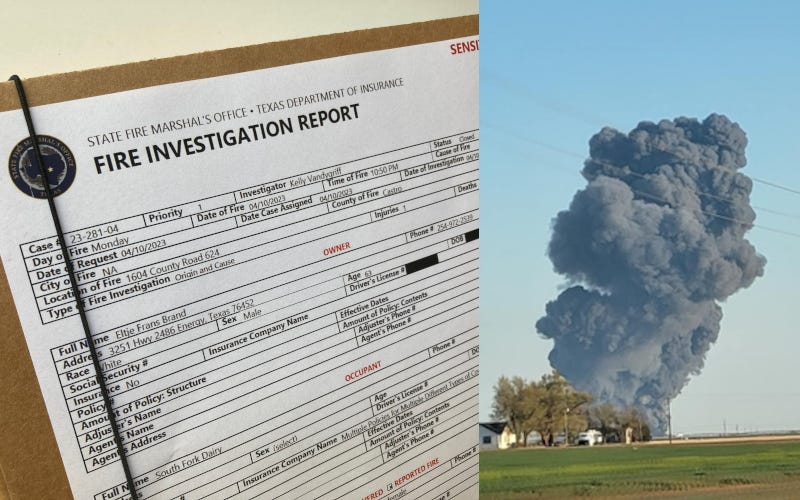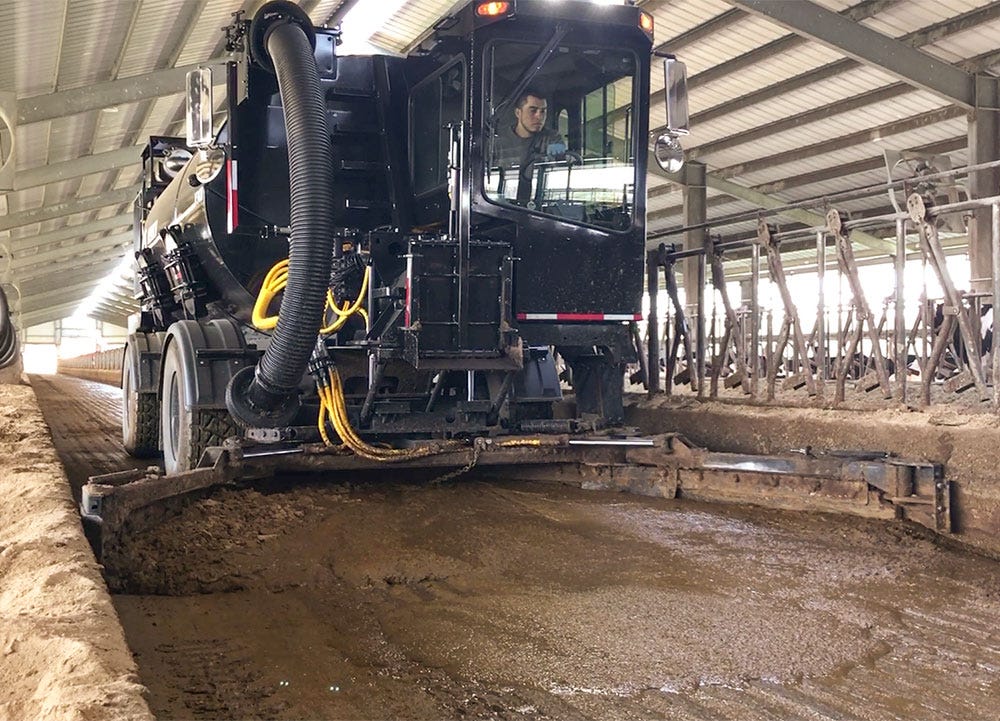The dash for biogas and the death of 18,000 cows
We investigate April's South Fork Dairy fire

On 10 April 2023, eye witnesses reported seeing a massive cloud of smoke hovering over a mega-barn at the South Fork Dairy near Dimmitt, Texas. The source was a huge fire in which an estimated 18,000 cows — 3% of the state’s entire dairy herd, worth tens of millions of dollars — burned to death.
Adding insult to injury, satellite imagery quickly confirmed that the barn was a brand new structure, only completed in 2020. A year earlier, the farm had been given permission to more than double its herd size to 32,000 cows, producing at least 50% more manure than environmental officials had originally authorised it to.

Despite being the deadliest cattle-related incident ever recorded by America’s Animal Welfare Institute, the South Fork fire quickly faded from view after an apparent cause emerged, with the Texas Tribune reporting on 19 May that investigators had pinned the blame on “an engine fire in a manure vacuum truck that was cleaning part of the barn.”
What’s a “manure vacuum truck” when it’s at home, and how did it end up killing so many cows? Curious, we decided to request the original State Fire Marshal’s report via an open records request. What we found was disturbing.

Fossil fuel execs ❤️ RNG
South Fork was expanding its herd in order to provide feedstock for an anaerobic digester producing so-called renewable natural gas (RNG) — a commodity we wrote about here back in January.
Historically, dairies have allowed the methane generated by cows’ manure to enter the atmosphere, contributing significantly to the greenhouse effect — as a brilliant data-driven investigation by Inside Climate News recently found, the largest single methane emitter in the whole of California is a giant cattle feedlot. Putting a sealed roof over slurry lagoons and capturing the resulting gas allows humans to make use of it, ideally offsetting an equivalent volume of fossil gas that would otherwise have been used and therefore providing a climate benefit.
Over the past decade, a winning combination of dairy industry lobbying, pork-barrel politics (more on that another time), well-intentioned environmental policy and strategic investment from fossil fuel companies has poured money into RNG and its sulphurous cousin biogas as purported climate solutions, with US farmers now making almost as much money from manure as they do from milk.

The planned digester at South Fork would have fed into the RNG portfolio of Clean Energy Fuels, a natural gas supplier founded in the late ‘90s by legendary Texas oilman T. Boone Pickens, and sometime meme-stock under the ticker CLNE.
Here’s Clean Energy CEO Andrew Littlefair on a 9 May earnings call:
Many of you have read about the tragic fire in South Fork Dairy in Texas, where we had plans to build an RNG digester. While we have funded some design, engineering and early equipment purchases for that project, we had not started on-site construction. And we are now working with the dairy owner as he plans to rebuild the barn and repopulate the herd.
Despite owning more than 1.2 million of the company’s shares (as of its latest filing), Littlefair is far from the real top dog at Clean Energy. In addition to stakes from large asset managers like BlackRock and passive fund managers like Vanguard, almost a fifth of CLNE shares are currently owned by French oil major TotalEnergies. The company also has joint ventures to develop digester projects with both Total and BP.
As InfluenceMap revealed last year, fossil fuel companies benefit from the RNG boom because it helps prolong the life of existing natural gas infrastructure like pipelines and treatment plants. When used as fuel for heavy vehicles — thereby earning lucrative Renewable Fuel Standard (RFS) credits in the US — it also outcompetes other solutions like electric trucks, risking keeping the world hooked on fossil gas for longer than we ideally need.
But if Clean Energy hadn’t yet broken ground on its digester project at South Fork, how can RNG be to blame for the fire?
The economics of scraping shit
The manure vacuum truck is a new invention: Mensch, the major manufacturer of the trucks for farms in the US, only applied for a patent in 2006, which was granted in 2008. The key advantage is in the economics of barn construction. As the manufacturer explains:
Barns no longer need to have an integrated manure handling system during construction. The Manure Vacuum replaces the need for pumps, augers, and concrete channels to transport manure from the barn to the storage lagoon or process facility.
Lower capital costs for barn construction translate into greater returns for investors on sales of milk and RNG. But there’s another advantage too, specifically for farms operating anaerobic digesters, which is that vacuum trucks allow manure to be collected quickly and regularly, without being diluted by water used for flushing it out. This is made clear in a report on digesters in California’s Chino Basin:
The dairies participating in the digester project have implemented certain changes that affect the management of manure at their operations. The most significant change affects the method and frequency of manure collection. Each participating dairy now uses a “honey vac” vacuum tanker truck to collect fresh manure along the feed lanes daily […] Manure must be collected within 24 hours of being excreted.
By 2023, vacuum trucks and other ‘honey vac’-type vehicles appear to have become a standard way for dairies to transfer manure from cattle housing to digesters. Data from California, which has the most generous subsidy scheme for digesters in the US, shows public money being used to purchase the machines.
But the Texas Fire Marshal’s report casts doubt on whether continuous operation of vacuum trucks in crowded barns is safe. According to the report, the fire at South Fork appeared to be caused by a fire in the engine compartment of a Mensch vacuum truck. The driver of the truck initially tried to drive it out of the barn, but couldn’t — with the help of another worker and two fire extinguishers, he then tried to put the fire out, but again wasn’t able to, leaving it to spread to the barn structure itself. The driver’s account was confirmed by three other employees and the dairy manager, who “all agreed that the fire originated in the manure vacuum truck.“
Surprisingly, the report also reveals that a truck of the same make and model had previously caught fire on the same farm, and was parked outside the barn at the time. A 2019 report from a local South Dakota paper also links a barn fire to a vacuum truck from the same manufacturer, though in this case a less catastrophic incident:
It was found that a truck used to clean bunkers in the dairy barn had caught on fire due to an unknown mechanical issue while a worker was operating it. It was found that the fire spread to some of the bunks in the barn […] The fire departments were able to contain the fire, and no (people) or livestock were injured. The estimated damage to the building was $100,000. The Mensch 3410 Vacuum Truck was a total loss and valued at $189,000.

Asked to comment on the findings of the Fire Marshal’s Report, a spokesperson for Mensch said that the identification of a fire in the engine compartment of the truck at South Fork was “based on a verbal statement made by one witness” and cautioned that “multiple investigators, insurance companies and parties are participating in the ongoing investigation.”
They continued: “No one has identified any issue with the machine, and we are not aware of any issue with the machine that would have caused a fire. In our nearly four decades of operation, we have had no claims about defective equipment that led to a fire and no recalls because of concerns over fire safety. […] Our machines are safe and reliable when properly maintained and operated.“
Getting intense
Clearly, operating trucks in crowded barns full of tens of thousands of live animals is a risky business — and while this incident doesn’t appear to have involved the combustion of methane itself, thanks to cross-ventilation keeping constant air-flow in the barn, the potential proximity of other barns to large digesters or gas storage could create further risks.
It is of course too early to attribute direct blame for the fire to either the manufacturer or the farmer, and investigations by insurers are likely still ongoing. The State Fire Marshal’s report itself rules that the fire was accidental. But it’s worth examining whether a deeper, structural cause is the relentless intensification of American dairy farming, driven at least in part by the subsidies and credits on offer from the RNG boom. Is it possible to build and operate an 18,000-cow barn in a way that is simultaneously fire-safe, cheap enough to work with the economics of RNG, and which allows for collection of manure on the tight schedule required by a digester?

Last week, Gas Networks Ireland — the semi-public company which owns the country’s gas distribution infrastructure — put out a report claiming that the island as a whole could end up producing 14 terawatt hours of RNG a year, a figure equivalent to a quarter of the Republic’s total 2022 gas consumption or half the theoretical maximum energy production of the UK’s planned Sizewell C nuclear plant. (As a former colleague pointed out on Twitter, the methodology left a lot to be desired.) More sober figures like Chris Huhne, former secretary of state for energy and climate change in the UK and now chair of a major EU biogas and RNG lobby group, are also touting the commodity as a significant part of Europe’s energy transition going forward.
Going all out to capture existing methane emissions from farms should clearly be welcomed, but if rushed economic incentives lead Europe into further adopting an American model of intensive livestock farming, the climate harms from growing herd sizes could very well offset this good work — not to mention the associated impacts on local water systems, risks to worker safety from unfamiliar gas capture and distribution equipment, concerns about antibiotic resistance and, of course, horrendous animal welfare issues.
A famous slogan from 2019’s mass protests in Chile went, roughly, as follows: “Neoliberalism was born in Chile and will die in Chile.“ Will Europe — long the world-leader in consumption of dairy alternatives — one day say the same for milk?




